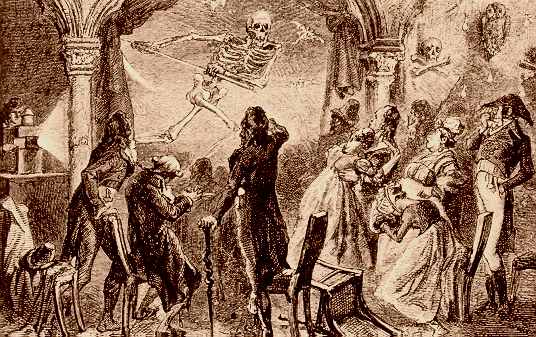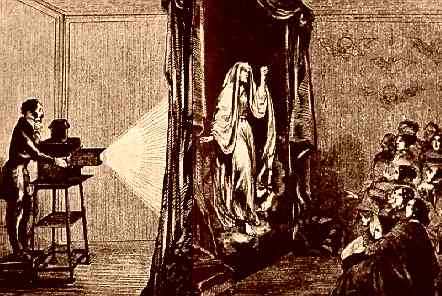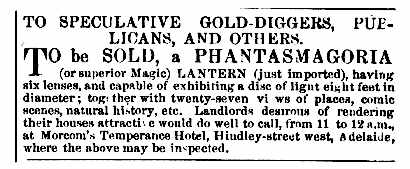 |
The Phantasmagoria.
The phantasmagoria was a particular application of the magic lantern which was used with frightening effect in the early part of the 19th century. The technique of rear-screen projection was used to create images on a translucent screen that was hung between the lantern and the audience. The pictures projected on the screen were usually demons, ghosts, skeletons, witches and other macabre, grotesque and fearsome figures. These could be made to rapidly grow larger on the screen, giving the impression they were rushing towards the audience, then at the last moment a shutter over the lens make them disappear, leaving an agitated audience in partial darkness. The sound of thunder and supernatural noises could be used to heighten the effect. Many different frightening effects were possible, and the illustration below depicts a phantasmagoric exhibition in progress. The lantern operator is on the left. These phantasmagorical shows were the ancestors of today’s horror movies and video nasties.
 |
By the time photography was invented, in 1839, the phantasmagoria was well-known and a description and illustration of the apparatus was published in the Encyclopedia Britannica, which said:
‘The apparatus for the phantasmagoria, or the raising of spectres, is nothing more than a magic lantern mounted upon wheels which, in place of throwing its pictures upon an opaque white ground, upon which the spectator looks, throws them upon one side of an imperfectly transparent screen, the spectator viewing them on the other side of the screen.’ The Britannica described the optics of the apparatus, the Argand lamp, the reflector and the two condenser lenses which concentated the light onto the images of the spectres and figures painted on the glass sliders. The lens shown in the Britannica’s illustration (below) appears to have been a simple convex magnifying glass.
 |
The lantern was mounted on a wheeled carriage which could be made to approach the screen from behind, or recede from it, ‘in consequence of which the figures may be able to contract into dwarfs, disappearing into a point of light, or swell out into giants of enormous magnitude.’ To compensate for the varying distance between the lantern and the back of the screen, which altered the focus and as well as the intensity of light falling on the screen, the apparatus had an ingenious auto-focussing and auto-aperture arrangement. A combination of frames, sliders, rods, levers and other contraptions caused the lens to slide backwards and forwards to give the correct focus, while a mask with a triangular cutout was allowed to rise and fall in front of the lens to give a constant intensity of light as the lantern was moved. And that technology was being used before photography was invented!
Below: Another illustration, c.1800, of a phantasmagoria without the automatic focussing and illumination mechanicals.

The term phantasmagoria was later used by entrepeneurs to add an air of magic and mystery to what were probably just ordinary magic lantern presentations. Today it is hard to know which South Australian phantasmagoric entertainments of the 19th century were genuine rear-screen exhibitions, and which were ordinary dissolving view programmes.
There was one type of lantern which was generally known as the Phantasmagoric lantern. It had a particular arrangement of optics and an Argand fountain lamp for illumination, and in the days when most slides projected were hand-painted it was the best-lit lantern that was available. But when photographic slides containing much more detail were produced magic lanterns with much better illumination were needed. When lamps burning mineral oil instead of vegetable oil were introduced they were much brighter than the Argand lamp in the phantasmagoric lantern, which was soon superseded.
 |
Left: Advert. for a ‘superior’
magic lantern. S.A. Register, 21 October 1853. |
End.